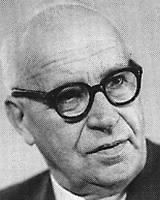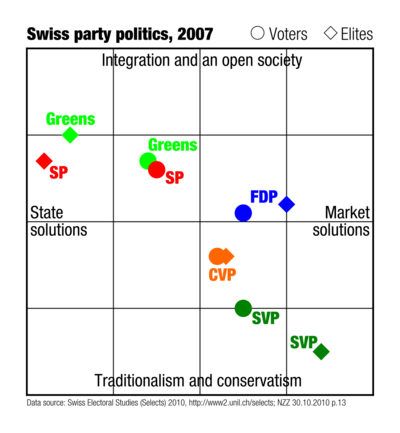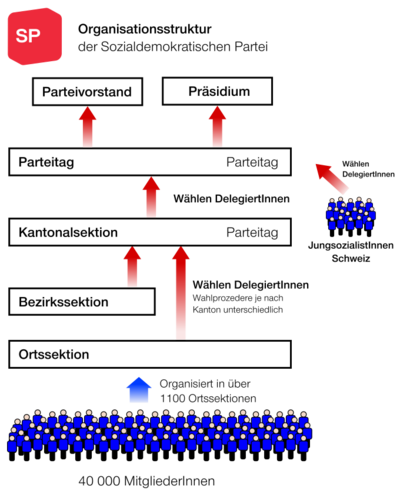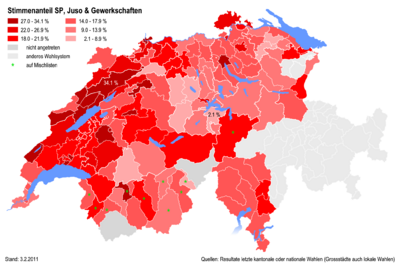Social Democratic Party of Switzerland facts for kids
Quick facts for kids
|
|
|---|---|
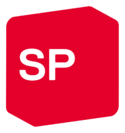 |
|
| Abbreviation | SP PS |
| President | Cédric Wermuth Mattea Meyer |
| Members in Federal Council | Élisabeth Baume-Schneider Beat Jans |
| Founded | 21 October 1888 |
| Headquarters | Theaterplatz 4, 3011 Bern |
| Youth wing | Young Socialists Switzerland |
| Membership (2015) | c. 30,000 |
| Ideology | Social democracy |
| Political position | Centre-left to left-wing |
| European affiliation | Party of European Socialists (associate) |
| International affiliation | Progressive Alliance |
| Colours | Red |
| Federal Council |
2 / 7
|
| Council of States |
9 / 46
|
| National Council |
41 / 200
|
| Cantonal executives |
28 / 154
|
| Cantonal legislatures |
442 / 2,544
|
| Website | |
| (German) (French) (Italian) |
|
The Social Democratic Party of Switzerland (SP) is one of the major political parties in Switzerland. It is also known by its French and Italian name, the Swiss Socialist Party (PS). The party was founded on October 21, 1888.
The SP is the second-largest party in Switzerland's government. It is a left-leaning party, which means it focuses on social justice and support for workers. Since 1960, the party has always had two members on the Federal Council, which is the group of seven people who lead the country. Currently, the SP's Federal Councillors are Élisabeth Baume-Schneider and Beat Jans.
The SP is one of the few Swiss parties that strongly supports Switzerland joining the European Union. The party also fights for workers' rights and wants to protect the environment. It is a member of the Progressive Alliance, a worldwide group of similar parties.
Contents
History of the Party
How the SP Began
Before the SP was created, Switzerland had many small groups fighting for workers' rights. These groups were part of the labour movement. On October 21, 1888, they came together to form the Social Democratic Party. Their goal was to solve social problems using democracy, not revolution. The first party president was Alexander Reichel from Bern.
In 1890, Jakob Vogelsanger became the first SP member elected to the National Council, one of the two houses of the Swiss parliament. At first, the voting system made it hard for the party to win many seats, even though it had many supporters. The party pushed for a new system called proportional representation, which would give parties seats based on the number of votes they received.
The World Wars and After
During World War I, Switzerland was neutral, but its people faced tough economic times. In 1918, the SP and labor unions organized a huge strike called the 1918 Swiss general strike. They demanded better working conditions and big changes in society. The government sent in the military to end the strike, but it led to important changes. A 48-hour work week was introduced, and the people voted for the proportional representation system the SP wanted. This helped the SP double its seats in the 1919 election.
After some internal disagreements, the party became more focused on making changes through government. In the 1943 Swiss federal election, the SP became the largest party in parliament. That same year, Ernst Nobs was elected as the first SP member of the Federal Council.
In 1959, a system called the "magic formula" was created. This was an agreement to share the seven seats on the Federal Council between the four largest parties. The SP has held two of these seats ever since, making it a permanent part of Switzerland's governing coalition.
Modern Times
In the 1970s and 1980s, the party attracted new supporters who were passionate about social issues and the environment. In 1983, the SP nominated Lilian Uchtenhagen, the first-ever female candidate for the Federal Council. Although she was not elected, Ruth Dreifuss became the first SP woman on the council ten years later.
The party has continued to support policies like joining European organizations, protecting the Alps from traffic, and promoting social equality. After losing some votes in the 2019 election, the SP gained back support in the 2023 Swiss federal election and now holds 41 out of 200 seats in the National Council.
What the SP Believes In
The SP's main goal is to create a fair and just society. It supports a government that provides strong public services like schools, healthcare, and transportation for everyone.
Economy and Social Programs
- Taxes: The party believes that wealthy people and large companies should pay higher taxes to help fund public services. This is called redistribution.
- Workers' Rights: The SP fights for fair wages, safe working conditions, and a reasonable retirement age.
- Public Services: It is against selling state-owned companies (like the post office or railways) to private businesses, a process known as privatization. It supports universal health care and paid leave for new parents.
Society and Environment
- Equality: The SP works for equality between men and women, including equal pay for equal work. It supports the rights of all people, including immigrants and same-sex couples.
- Environment: The party has strong environmental policies. It wants to fight climate change by supporting renewable energies and reducing pollution. It also wants to move more goods from trucks to trains to protect the Swiss Alps.
- Foreign Policy: The SP believes Switzerland should be more involved in international organizations and wants the country to join the European Union. It supports a policy of peace and is against joining military groups like NATO.
Party Structure
The SP is built from the ground up. It has about 900 local groups, called sections, in cities and towns across Switzerland. Every member belongs to a local section. These sections choose representatives, called delegates, to attend meetings for their canton (a region like a state).
Each of the 26 cantonal sections then elects delegates to go to national party conferences. These conferences are where the party makes its most important decisions.
The SP also has a youth wing called the Young Socialists Switzerland (JUSO). JUSO is politically independent but receives support from the main party. It acts like a cantonal section and can send delegates to national conferences.
Election Results
The SP is one of the strongest political parties in Switzerland. In the 2023 Swiss federal election, the party received 18.3% of the vote. This gave them 41 seats in the National Council, the lower house of parliament.
The party also has 9 seats in the Council of States, the upper house. The SP is especially strong in cities and French-speaking parts of Switzerland.
See also
 In Spanish: Partido Socialista Suizo para niños
In Spanish: Partido Socialista Suizo para niños



